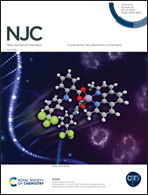A mitochondria-targeting “off–on” AIE probe with large Stokes shift for high-contrast H2S imaging in living cells†
Abstract
Hydrogen sulfide (H2S) produced and metabolized by mitochondria is closely associated to human physiological function, but its mechanism is not fully revealed due to the difficulty in determining the dose of hydrogen sulfide. Therefore, fluorescent probes with both excellent mitochondrial targeting ability and rapid H2S detection are urgently needed. In this work, a novel fluorescent probe, TPAS-TN, was developed to detect H2S in mitochondria. TPAS-TN with a D–π–A structure had a large Stokes shift (213 nm), and possessed low background interference in cell imaging. By introducing a twisted triphenylamine group as the donor, TPAS-TN was endowed with AIE properties, and the positively charged pyridium unit was the acceptor, so that TPAS-TN exhibited good mitochondrial targeting ability and biocompatibility. Meanwhile, the π-bridge was composed of phenyl and dinitrophenyl (DNP) ether to make TPAS-TN exhibit “off–on” properties, low detection limit (69.5 nM), and high sensitivity and selectivity. Besides, TPAS-TN with the above characteristics was successfully applied to high-contrast H2S imaging in mitochondria.



 Please wait while we load your content...
Please wait while we load your content...